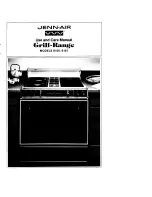
3
Ventilation
The use of a cooking appliance results in the production
of heat and moisture in the room in which it is installed.
Therefore, make sure that the kitchen is well ventilated:
keep natural ventilation holes open or install a powered
cookerhood that vents outside. If you have several hotplates/
burners on, or use the cooker for a long time, open a window
or turn on an extractor fan
Maintenance
• It is recommended that this appliance is serviced
annually.
•
DO NOT
use cooking vessels on the hotplate that
overlap the edges.
• Unless specified otherwise in this guide, always allow
the cooker to cool and then switch it off at the mains
before cleaning or carrying out any maintenance work.
•
DO NOT
use the control knobs to manoeuvre the
cooker.
•
NEVER
operate the cooker with wet hands.
•
DO NOT
use a towel or other bulky cloth in place of a
glove – it might catch fire if brought into contact with a
hot surface.
•
DO NOT
use hotplate protectors, foil or hotplate covers
of any description. These may affect the safe use of
your hotplate burners and are potentially hazardous to
health.
•
NEVER
heat unopened food containers. Pressure build
up may make the containers burst and cause injury.
•
DO NOT
use unstable saucepans. Always make sure that
you position the handles away from the edge of the
hotplate.
•
NEVER
leave the hotplate unattended at high heat
settings. Pans boiling over can cause smoking,
and greasy spills may catch on fire. Use a deep fat
thermometer whenever possible to prevent fat
overheating beyond the smoking point.
• Unattended cooking on a hob with fat or oil can be
dangerous and may result in fire.
•
NEVER
leave a chip pan unattended. Always heat fat
slowly, and watch as it heats. Deep fry pans should be
only one third full of fat.
•
NEVER
try to move a pan of hot fat, especially a deep
fat fryer. Wait until the fat is cool. Filling the pan too full
of fat can cause spill over when food is added. If you use
a combination of oils or fats in frying, stir them together
before heating, or as the fats melt.
• Foods for frying should be as dry as possible. Frost on
frozen foods or moisture on fresh foods can cause hot
fat to bubble up and over the sides of the pan. Carefully
watch for spills or overheating of foods when frying at
high or medium high temperatures.
•
DO NOT
use the top of the flue (the slot along the back
of the cooker) for warming plates, dishes, drying tea
towels or softening butter.
•
DO NOT
use water on grease fires and never pick up
a flaming pan. Turn the controls off and then smother
a flaming pan on a surface unit by covering the pan
completely with a well fitting lid or baking tray. If
available, use a multi-purpose dry chemical or foam-
type fire extinguisher.
•
DO NOT
modify this appliance. This appliance is not
intended to be operated by means of external timer or
separated remote-control system.
• If flammable materials are stored in the drawer, oven(s)
or grill(s) it may explode and result in fire or property
damage.
Induction and Ceramic Care
•
Important information for pacemaker and
implanted insulin pump users:
The functions of this
hob comply with the applicable European standards
on electromagnetic interference. If you are fitted
with a pacemaker or implanted insulin pump and are
concerned please consult your doctor for medical
advice.
• When the hob is in use keep magnetic items away, such
as credit and debit cards, floppy disk, calculators, etc.
• Take care when touching the marked cooking areas of
the hob.
• Use adequately sized pans with flat bottoms that are
large enough to cover the surface of the hotplate
heating area. Using undersized pans will expose a
portion of the hotplate surface to direct contact and
may result in the ignition of clothing
• Only certain types of glass, glass-ceramic, earthenware
or other glazed containers are suitable for use on the
warming zone; others may break because of the sudden
change in temperature.
• Only certain types stainless steel, enamelled steel pans
or cast iron pans with enamelled bases are suitable for
induction hob cooking.
• Take care
NOT
to scratch the surface when placing
cookware on the glass panel.
• Only certain types of glass, glass-ceramic, earthenware
or other glazed containers are suitable for hotplate
cooking; others may break because of the sudden
change in temperature.
NEVER
cook directly on the hob
surface
(Fig. 1.1)
.
•
DO NOT
leave the hob zones switched on unless being
used for cooking.
•
DO NOT
stand or rest heavy objects on the hob.
Although the ceramic surface is very strong, a sharp
blow or sharp falling object (e.g. a salt cellar) might
cause the surface to crack or break
(Fig. 1.2)
.
• Should a crack appear in the surface, disconnect the
appliance immediately from the supply and arrange for
its repair.
• Always
LIFT
pans off the hob. Sliding pans may cause
marks and scratches
(Fig. 1.3)
.
Содержание Excel 110 Ceramic
Страница 1: ...Excel 110 Dual Fuel USER GUIDE INSTALLATION INSTRUCTIONS Built from experience ...
Страница 4: ...iv ...
Страница 42: ...27 Notes ...








































